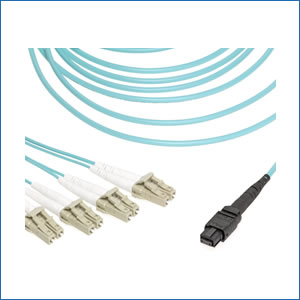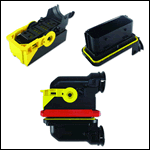How to Specify Small Form Factor Optical Connectors
Over the last three decades, a myriad of optical connectors have come and gone, but small form factor connectors are making the choice easier these days. Molex offers tips on how to specify small form factor optical connectors.

Molex MTP-to-LC eight-fiber multi-mode breakout cable shows the density differential of the two leading optical connector interfaces.
In a maturing market, there are clear winners that prove superior and push out competing technologies. In the optical interconnect marketplace, this has occurred with small form factor optical connectors. Over the last three decades, a myriad of optical connectors have come and gone, and LC and MTP*/MPO interconnects have emerged as clear winners for users, systems designers, and optical component and transceiver designers worldwide.
LC connectors offer the optimal performance and ease of use of a ceramic ferrule-based connector. MTP/MPO interconnect interfaces provide ultimate density with some tradeoffs for optical performance and concentration of fiber ports. While legacy SC connectors are selected for lower-density patch panels and optical modules, FC connectors are designed for more robust test equipment environments. In most applications, ST, SC, and FC connector use is declining due to the obvious benefits of LC and MTP/MPO connectors.
LC interconnects offer support for a wide variety of cable diameters, strain relief boots, or bend limiters. Pull tabs help the LC achieve its maximum patch-panel density, while maintaining usability. For singlemode applications, APC (angle-polished) versions help achieve superior back-reflection performance. The LC connectors feature an optional six-position rotational ferrule tuning, which allows for the lowest possible insertion loss performance when required.
When higher fiber density is required, the solution often demands a jump from ceramic ferrule-based connectors to precision molded MT multi-fiber ferrule-based connectors. This is where things can get more complicated. Let’s take a step back to clarify terminology:
- MT ferrule – Precision molded ferrule offering support for two to 72 optical fibers utilized as the fiber aligning element of an MTP/MPO connector
- Guide pin – Part of the pin-and-hole alignment mechanism employed by the MT ferrule, which provides precision alignment of multiple fibers across the two mating MT ferrules
- MPO connector – Industry-standard multi-fiber rectangular push/pull connector interface that houses the MT ferrule in a male side (with guide pin)/female side (no pin) configuration
- MTP connector – Vendor-specific trademarked version of the MPO connector interface, which improves optical and mechanical performance of the optical interface especially when mating to optical modules
MTP/MPO interfaces support multimode and singlemode fiber types in many different fiber counts, cable constructions, and cable ODs, driven by fiber count and application. Optical performance of the interface is derived by the precision molding process of the MT ferrule as well as polishing processes for the glass optical fibers, both of which have improved vastly over the years. Singlemode MT ferrules are angle-polished for improved return loss performance while multimode ferrules are PC (flat)-polished. There are a number of standards driving the fiber counts for the MTP/MPO when used with specific optical modules such as QSFP (eight functional fibers, four center fibers unused) or CXP (24 fibers). New standards will define 16- and 32-fiber versions.
MTP/MPO technology offers vast density improvements over LC ceramic ferrule-based connectors at the per-fiber port level. However, this requires careful assessment of the fiber management aspects for designers, installers, and end-users as to moves, additions, and changes over the cable infrastructure lifetime.
[hr]
Author Tom Marrapode is director of advanced technology development for the Molex Optical Solutions Connectivity Group.
*MTP is a registered trademark of US CONEC.





